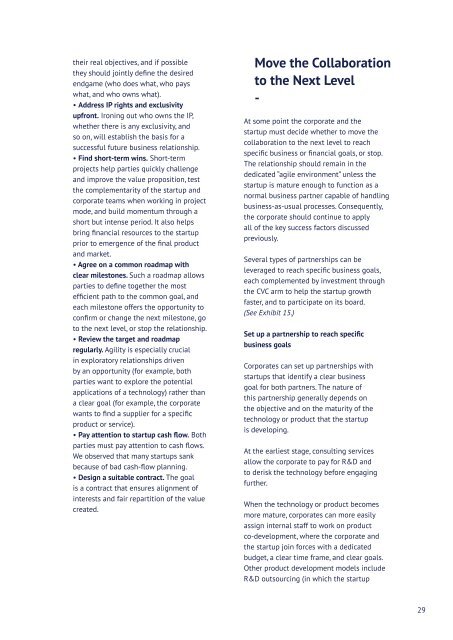From Tech to Deep Tech
from-tech-to-deep-tech
from-tech-to-deep-tech
You also want an ePaper? Increase the reach of your titles
YUMPU automatically turns print PDFs into web optimized ePapers that Google loves.
their real objectives, and if possible<br />
they should jointly define the desired<br />
endgame (who does what, who pays<br />
what, and who owns what).<br />
• Address IP rights and exclusivity<br />
upfront. Ironing out who owns the IP,<br />
whether there is any exclusivity, and<br />
so on, will establish the basis for a<br />
successful future business relationship.<br />
• Find short-term wins. Short-term<br />
projects help parties quickly challenge<br />
and improve the value proposition, test<br />
the complementarity of the startup and<br />
corporate teams when working in project<br />
mode, and build momentum through a<br />
short but intense period. It also helps<br />
bring financial resources <strong>to</strong> the startup<br />
prior <strong>to</strong> emergence of the final product<br />
and market.<br />
• Agree on a common roadmap with<br />
clear miles<strong>to</strong>nes. Such a roadmap allows<br />
parties <strong>to</strong> define <strong>to</strong>gether the most<br />
efficient path <strong>to</strong> the common goal, and<br />
each miles<strong>to</strong>ne offers the opportunity <strong>to</strong><br />
confirm or change the next miles<strong>to</strong>ne, go<br />
<strong>to</strong> the next level, or s<strong>to</strong>p the relationship.<br />
• Review the target and roadmap<br />
regularly. Agility is especially crucial<br />
in explora<strong>to</strong>ry relationships driven<br />
by an opportunity (for example, both<br />
parties want <strong>to</strong> explore the potential<br />
applications of a technology) rather than<br />
a clear goal (for example, the corporate<br />
wants <strong>to</strong> find a supplier for a specific<br />
product or service).<br />
• Pay attention <strong>to</strong> startup cash flow. Both<br />
parties must pay attention <strong>to</strong> cash flows.<br />
We observed that many startups sank<br />
because of bad cash-flow planning.<br />
• Design a suitable contract. The goal<br />
is a contract that ensures alignment of<br />
interests and fair repartition of the value<br />
created.<br />
Move the Collaboration<br />
<strong>to</strong> the Next Level<br />
-<br />
At some point the corporate and the<br />
startup must decide whether <strong>to</strong> move the<br />
collaboration <strong>to</strong> the next level <strong>to</strong> reach<br />
specific business or financial goals, or s<strong>to</strong>p.<br />
The relationship should remain in the<br />
dedicated “agile environment” unless the<br />
startup is mature enough <strong>to</strong> function as a<br />
normal business partner capable of handling<br />
business-as-usual processes. Consequently,<br />
the corporate should continue <strong>to</strong> apply<br />
all of the key success fac<strong>to</strong>rs discussed<br />
previously.<br />
Several types of partnerships can be<br />
leveraged <strong>to</strong> reach specific business goals,<br />
each complemented by investment through<br />
the CVC arm <strong>to</strong> help the startup growth<br />
faster, and <strong>to</strong> participate on its board.<br />
(See Exhibit 15.)<br />
Set up a partnership <strong>to</strong> reach specific<br />
business goals<br />
Corporates can set up partnerships with<br />
startups that identify a clear business<br />
goal for both partners. The nature of<br />
this partnership generally depends on<br />
the objective and on the maturity of the<br />
technology or product that the startup<br />
is developing.<br />
At the earliest stage, consulting services<br />
allow the corporate <strong>to</strong> pay for R&D and<br />
<strong>to</strong> derisk the technology before engaging<br />
further.<br />
When the technology or product becomes<br />
more mature, corporates can more easily<br />
assign internal staff <strong>to</strong> work on product<br />
co-development, where the corporate and<br />
the startup join forces with a dedicated<br />
budget, a clear time frame, and clear goals.<br />
Other product development models include<br />
R&D outsourcing (in which the startup<br />
29




